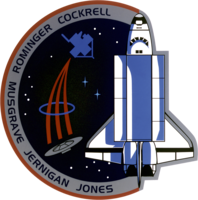STS-80
 | |
| Dane misji | |
| Indeks COSPAR | 1996-065A |
|---|---|
| Zaangażowani | |
| Oznaczenie kodowe | STS-80 |
| Pojazd | |
| Wahadłowiec | |
| Załoga | |
 Od lewej: Kent Rominger, Tamara Jernigan, F. Story Musgrave, Thomas D. Jones, Kenneth Cockrell. | |
| Dowódca | |
| Start | |
| Miejsce startu | |
| Początek misji | 19 listopada 1996 19:55:47 UTC |
| Orbita okołoziemska | |
| Apogeum | 351 km |
| Lądowanie | |
| Miejsce lądowania | |
| Lądowanie | 7 grudnia 1996 11:49:05 UTC |
| Czas trwania misji | 17 dni, 15 godz, 53 min, 18 sek[1] |
| Przebyta odległość | ponad 11,2 mln km[1] |
| Liczba okrążeń Ziemi | 279[1] |
| Program lotów wahadłowców | |
STS-80 (ang. Space Transportation System) – dwudziesta pierwsza misja amerykańskiego wahadłowca kosmicznego Columbia i osiemdziesiąty lot programu lotów wahadłowców. Misja trwała ponad siedemnaście dni[2].
Załoga
- źródło[2]
- Kenneth Cockrell (3)*, dowódca (CDR)
- Kent Rominger (2), pilot (PLT)
- Tamara „Tammy” Jernigan (4), specjalista misji (MS1)
- Thomas D. Jones (3), specjalista misji (MS2)
- Franklin „Story” Musgrave (6), specjalista misji (MS3)
- *(liczba w nawiasie oznacza liczbę lotów odbytych przez każdego z astronautów)
Parametry misji
- Masa:
- startowa orbitera: - kg
- lądującego orbitera: - kg
- ładunku: 13 006 kg
- Perygeum: 318 km[3]
- Apogeum: 375 km[3]
- Inklinacja: 28,5°[3]
- Okres orbitalny: 91,5 min[3]
Cel misji
- Umieszczenie na orbicie, a następnie przechwycenie swobodnie latających platform badawczych ORFEUS-SPAS II (Orbiting Retrievable Fal and Extreme Ultraviolet Spectrometr) oraz WSF-3 (Wake Shield Facility)[2].
Platforma SPAS II (Shuttle Pallet Satellite) była wykorzystana do badań naukowych. Do jej umieszczenia poza lukiem promu służył manipulator wahadłowca. Kosmiczny spacer nie był potrzebny[4].
Dwa zaplanowane spacery kosmiczne nie doszły do skutku z powodu problemu z otwarciem luku śluzy powietrznej[3].
Zobacz też
Przypisy
- ↑ a b c podsumowanie misji STS-80 na stronie KSC (ang.)
- ↑ a b c Tomáš Přibyl: Dzień, w którym nie wróciła COLUMBIA. Bielsko-Biała: Wydawnictwo >DEBIT<, 2003, s. 171-172. ISBN 83-7167-224-1.
- ↑ a b c d e Mark Wade: STS-80 (ang.). W: Encyclopedia Astronautica [on-line]. [dostęp 2017-07-25].
- ↑ Misje free-flyer. Poznań: Amermedia Sp. z o.o., 2014, s. 21, seria: Kosmos. Tajemnice Wszechświata. Encyklopedia Astronomii i Astronautyki.. ISBN 978-83-252-2324-3.
Linki zewnętrzne
- podsumowanie misji STS-80 na stronie KSC (ang.)
- Mark Wade: STS-80 (ang.). W: Encyclopedia Astronautica [on-line]. [dostęp 2017-07-25].
- Spaceflight mission report: STS-80 (ang.). Spacefacts. [dostęp 2017-07-25].
Media użyte na tej stronie
The flag of Navassa Island is simply the United States flag. It does not have a "local" flag or "unofficial" flag; it is an uninhabited island. The version with a profile view was based on Flags of the World and as a fictional design has no status warranting a place on any Wiki. It was made up by a random person with no connection to the island, it has never flown on the island, and it has never received any sort of recognition or validation by any authority. The person quoted on that page has no authority to bestow a flag, "unofficial" or otherwise, on the island.
This mission patch for mission STS-80 depicts the Space Shuttle Columbia and the two research satellites its crew deployed into the blue field of space. The uppermost satellite is the Orbiting Retrievable Far and Extreme Ultraviolet Spectrograph-Shuttle Pallet Satellite (ORFEUS-SPAS), a telescope aimed at unraveling the life cycles of stars and understanding the gases that drift between them. The lower satellite is the Wake Shield Facility (WSF), flying for the third time. It will use the vacuum of space to create advanced semiconductors for the nation's electronics industry. ORFEUS and WSF are joined by the symbol of the Astronaut Corps, representing the human contribution to scientific progress in space. The two bright blue stars represent the mission's Extravehicular Activities (EVA), final rehearsals for techniques and tools to be used in assembly of the International Space Station (ISS). Surrounding Columbia is a constellation of 16 stars, one for each day of the mission, representing the stellar talents of the ground and flight teams that share the goal of expanding knowledge through a permanent human presence in space.
The crew assigned to the STS-80 mission included (seated left to right) Kent V. Rominger, pilot; and Kenneth D. Cockrell, commander. Standing (left to right) are mission specialists Tamara E. Jernigan, F. Story Musgrave, and Thomas D. Jones. Launched aboard the Space Shuttle Columbia on November 19, 1996 at 2:55:47 pm (EST), the STS-80 mission marked the final flight of 1996. The crew successfully deployed and operated the Orbiting and Retrievable Far and Extreme Ultraviolet Spectrometer-Shuttle Pallet Satellite II (ORFEUS-SPAS II), and deployed and retrieved the Wake Shield Facility-3 (WSF-3).
- ORFEUS-SPAS II free-flying telescop released by Space Shuttle Columbia on STS-80 (1996)
- original description: This STS-80 onboard photograph shows the Orbiting Retrievable Far and Extreme Ultraviolet Spectrometer-Shuttle Pallet Satellite II (ORFEUS-SPAS II), photographed during approach by the Space Shuttle Orbiter Columbia for retrieval. Built by the German Space Agency, DARA, the ORFEUS-SPAS II, a free-flying satellite, was dedicated to astronomical observations at very short wavelengths to: investigate the nature of hot stellar atmospheres, investigate the cooling mechanisms of white dwarf stars, determine the nature of accretion disks around collapsed stars, investigate supernova remnants, and investigate the interstellar medium and potential star-forming regions. Some 422 observations of almost 150 astronomical objects were completed, including the Moon, nearby stars, distant Milky Way stars, stars in other galaxies, active galaxies, and quasar 3C273. The STS-80 mission was launched November 19, 1996.




